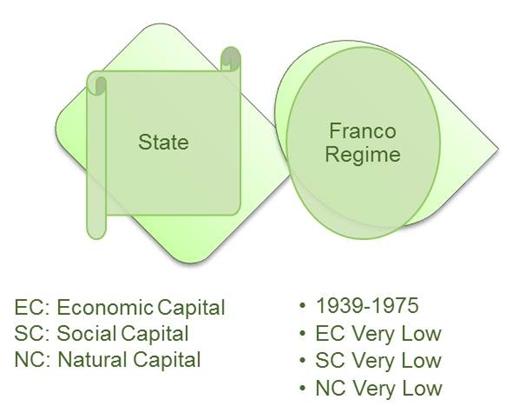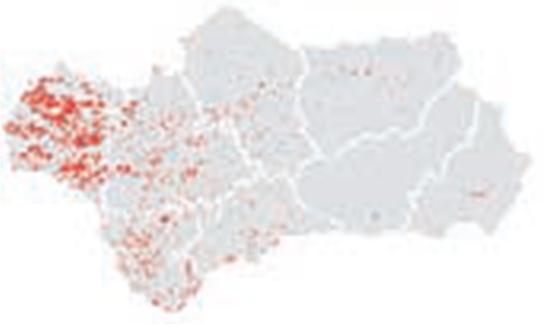Study sites in cropland
Study sites in grazing land
Study sites in forests
Franco Regime (1939 to 1975)
| Authors: | Michiel Curfs, Anton Imeson |
| Coordinating authors: | Agostino Ferrara, Giovanni Quaranta, Rosanna Salvia |
| Editors: | Alexandros Kandelapas, Jane Brandt |
Editor's note 20Mar14: Source D332-4.2.2
Assessment of the components of the three capitals
During this period, strict dictatorial regimes are controlling and driving most, if not all, of the changes in natural, social and economic capital components in Spain and also in Portugal. The political regime is a critical function of the social capital.
Changes affecting the study site occur primarily on the national level. The general focus is on transforming Spain from an agrarian to an industrial state. While there is great growth of cities, the rural Baixo Guadiana witnesses an exodus. Swine fever and the discouraging political regime have a huge impact on the decrease of the Dehesa and an increase in mechanization and big investments. For the Baixo Guadiana, however, after the closure of the mines, employment is scarce and agricultural business is nearly impossible considering the land use changes and political regime. The rural landscape changes dramatically but natural capital remains low. Socially, the strict regime does not create high standards in the social components such as, willingness to participate. Trust is low. However, a growing contraband economy can perhaps be interpreted as a sign of functioning local networks and trust, in some villages, but also in the region as a whole.
In the 1960s, the first experiments with strawberries start in coastal areas near Huelva. This crop, the "red gold" reaches a maximum of 11,000 ha of cultivation in the 1980s.

Critical functions
During the 1940s (and WWII) poverty and lack of food are widespread and continue due the economic isolation (and embargo) of the Francoist regime. The Spanish state takes several steps towards autarky (self-sufficiency) until the 1959 stabilization plan which aims at opening up the economy to the rest of Europe. During the 1960s and 70s some 2.5 million Spanish agricultural workers leave to find work elsewhere. The introduction of mechanization and widespread irrigation brings an annual increase in production of 3%.
In contrast, the population of Baixo Guadiana reverts to subsistence agriculture or employment in larger farms with little mechanisation. Wheat and cereals are the dominant crop complemented by traditional care of livestock (Iberian pork, goats and sheep). The area includes several flour producing factories and several famous grain dryers. Harsh and irregular climate often lead to disastrous years and immediate famine. Resilience of rural villages is low: people are poor, infrastructure bad and villages isolated. The political regime does not focus on rural Spain and the drive to change from an agrarian to an industrial state does not benefit rural villages in the study site. The traditional agro-silvo pastoral Dehesa system, based upon the balance between livestock, men and trees (oaks) and which has created the typical landscape surrounding Sanlúcar de Guadiana, persists providing both wood and meat products, despite the general rural exodus.
Income (cash) supplements come from precious few sources such as the manufacturing of baskets from wicker and cane growing along the sides of the river. In fact, the village economy is largely based on women's work. A contraband economy also arises along the border and the river Guadiana. It includes smuggling (tobacco, coffee) and provides livelihood for some inhabitants.
The most critical component of the period is the political regime. Despite the general economic growth (outside the study site), the influence of the regime in communities and families is disruptive and overshadows all aspects of social and economic life.
Critical variables
After the Spanish Civil War (1936-1939) and Franco's coming into power, many bloody reprisals are inflicted upon left wing officials and their allies. The dictatorial power structure incorporates the local bureaucracy, the Guardia Civil, agricultural landowners and the local decision-making bodies (municipal council, agricultural council). This process is also observed in Sanlúcar de Guadiana where families that take "control" at the end of the civil war, still possess the big land pieces and still hold important decision making positions (examples of path dependency and lock in mechanisms).
Until the 1950s barter is still a very common activity to pay for products or services. The province of Huelva is a good example of changes in relation to the new goals set out by the government in 1959, namely the development of industry and tourism. In the period 1964-1975 more than 10 industrial projects are realised in the city of Huelva which expands (quickly and without plan) into an industrial city, attracting many rural citizens. Industries are primarily chemical although of major significance to the biophysical system is the rise of the paper-pulp industry. Many areas are forested with pines and eucalyptus plantations. Although the total land occupied by eucalyptus plantations in Andalucia is 0.81%, most of the plantations are found the province of Huelva.

By end of the 1960s in Baixo Guadiana, rural depopulation (which had already started in the 1950s) is almost complete with people moving to Huelva and Andalucía, Mallorca or Barcelona. In the early 1970s, after the oil crisis, de-industrialisation is rapid is was the rise in unemployment.
Main LEDD problems
As seen above, the 1950s are particularly hard times. Agriculture is also hampered by:
- the expansion of timber and pulp plantations disrupting agricultural landscapes. Agriculture is actively discouraged, often to the point of forced depopulation;
- swine pest resulting in great economic losses for many villages, as many people particularly in the dehesa, rely on their livestock. Loss of animals affects the ecosystem as a whole.
During the 60s and 70s Sanlúcar de Guadiana is ruled by 4 families employing villagers as labourers (jornaleros). Diverse activities, such as basket weaving and contraband contribute to revenues in Sanlúcar de Guadiana and might be seen as an example of traditional multifunctionality and pluri-activity.
Policy context
AK: to check that implementation, impacts and effectiveness of selected policies are discussed in this text. Look at D342 to see if there is any additional information.
On the Portuguese side of the river, the main policy since 1929 is the Wheat Campaign that aims to attach the agricultural population to rural land and reduce unemployment. The wheat campaign leads to a massive landscape transformation, clear-cutting and severe erosion.
On the Spanish side, the mining crisis dominates and involves the nationalization, rapid decline and eventual disappearance of mining activity.
After two decades of autarky, the Spanish economy starts to open up in the 1960s partly as a result of shifts in broader international relations. National policies push for outmigration of rural populations and industrialization. Thus the exodus from rural areas is part of a wider policy plan: at the national level, agricultural employment falls from over 40% to under 25% with exodus of more than two million workers between 1961 and 1970. Migrating to cities and coastal zones and employment in industry and tourism are for many the only viable option.
Properties of the system
AK: to check if there is any further relevant information in D333
Socio-ecological resilience
AK: to be added, source: D333
Socio-ecological fit of the dominant response to LEDD
AK: to be added, source: D333
